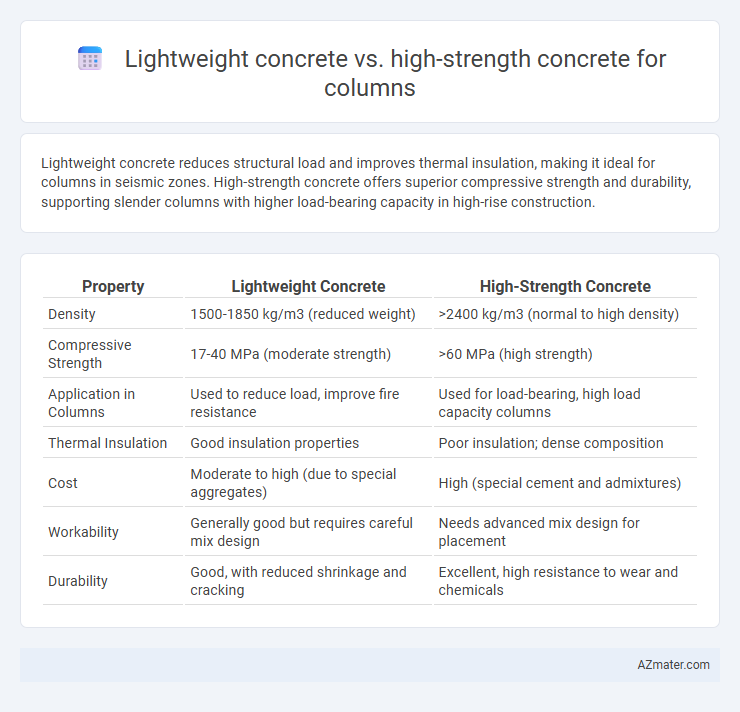Lightweight concrete reduces structural load and improves thermal insulation, making it ideal for columns in seismic zones. High-strength concrete offers superior compressive strength and durability, supporting slender columns with higher load-bearing capacity in high-rise construction.
Table of Comparison
| Property | Lightweight Concrete | High-Strength Concrete |
|---|---|---|
| Density | 1500-1850 kg/m3 (reduced weight) | >2400 kg/m3 (normal to high density) |
| Compressive Strength | 17-40 MPa (moderate strength) | >60 MPa (high strength) |
| Application in Columns | Used to reduce load, improve fire resistance | Used for load-bearing, high load capacity columns |
| Thermal Insulation | Good insulation properties | Poor insulation; dense composition |
| Cost | Moderate to high (due to special aggregates) | High (special cement and admixtures) |
| Workability | Generally good but requires careful mix design | Needs advanced mix design for placement |
| Durability | Good, with reduced shrinkage and cracking | Excellent, high resistance to wear and chemicals |
Introduction to Concrete Types for Columns
Lightweight concrete for columns offers reduced structural load and improved thermal insulation, making it ideal for tall buildings where weight is a critical factor. High-strength concrete excels in columns requiring exceptional load-bearing capacity and durability, commonly used in high-rise and industrial structures. Understanding the specific compressive strengths and densities of these concrete types helps engineers optimize column design for performance and safety.
Definition of Lightweight Concrete
Lightweight concrete is a type of concrete characterized by its lower density, typically achieved by incorporating lightweight aggregates such as expanded clay, shale, or pumice, which reduces the overall structural weight of columns. It offers enhanced thermal insulation and fire resistance compared to traditional high-strength concrete, which prioritizes compressive strength through dense aggregates and higher cement content. While high-strength concrete columns support heavy loads with superior durability, lightweight concrete columns are advantageous in reducing dead load, easing foundation requirements, and improving seismic performance.
Definition of High-Strength Concrete
High-strength concrete (HSC) is defined by its compressive strength exceeding 6,000 psi (approximately 40 MPa), making it suitable for columns requiring superior load-bearing capacity and durability. Unlike lightweight concrete, which prioritizes reduced density for weight savings, HSC achieves enhanced mechanical properties through optimized mix designs incorporating supplementary cementitious materials and low water-to-cement ratios. Columns constructed with high-strength concrete benefit from increased structural efficiency and resistance to environmental stressors.
Key Material Differences
Lightweight concrete for columns primarily uses lightweight aggregates such as expanded clay or shale, resulting in a lower density of around 1440-1840 kg/m3 compared to high-strength concrete, which typically has a density of 2400 kg/m3 due to normal weight aggregates like crushed stone and sand. The compressive strength of lightweight concrete usually ranges from 17 to 35 MPa, whereas high-strength concrete exceeds 50 MPa, achieved through a higher cement content, lower water-cement ratio, and the inclusion of supplementary cementitious materials like silica fume. Porosity differences also play a critical role; lightweight concrete has higher porosity leading to better thermal insulation, while high-strength concrete's dense microstructure enhances durability and load-bearing capacity in column applications.
Structural Performance Comparison
Lightweight concrete exhibits lower density and reduced dead load, enhancing seismic performance while offering adequate compressive strength for columns in medium-rise structures. High-strength concrete provides superior load-bearing capacity with compressive strengths typically exceeding 50 MPa, making it ideal for high-rise buildings requiring slender columns and higher stiffness. Structural performance comparison reveals that lightweight concrete improves ductility and energy absorption, whereas high-strength concrete excels in ultimate load capacity and long-term durability under heavy axial loads.
Load-Bearing Capacity Analysis
Lightweight concrete exhibits reduced density, leading to lower dead loads on columns while maintaining adequate load-bearing capacity for medium-rise structures. High-strength concrete offers significantly higher compressive strength, enhancing column load-bearing capacity and allowing for slender designs in high-rise buildings. Analyzing load-bearing capacity emphasizes the balance between structural weight and strength requirements, with high-strength concrete preferred for maximum load support and lightweight concrete used to optimize overall structural efficiency.
Durability and Longevity
Lightweight concrete offers enhanced durability in columns by reducing dead load and improving seismic performance, while high-strength concrete provides superior compressive strength and resistance to environmental stressors, ensuring long-lasting structural integrity. The lower density of lightweight concrete minimizes foundation pressure, contributing to extended service life, whereas high-strength concrete's dense microstructure resists chloride penetration and freeze-thaw cycles more effectively. Both materials improve column longevity, but high-strength concrete is preferred in aggressive environments requiring maximum durability.
Construction and Installation Considerations
Lightweight concrete offers easier handling and reduced structural load in column construction, facilitating faster installation and lowering labor costs. High-strength concrete, while providing superior load-bearing capacity and durability, requires meticulous mixing, curing, and placement to avoid cracking and ensure optimal performance. Selecting between the two depends on project priorities such as structural requirements, speed of construction, and budget constraints.
Cost Implications and Economic Factors
Lightweight concrete typically offers reduced transportation and handling costs due to its lower density, making it economically advantageous for columns in tall structures where weight reduction translates into savings on foundation and structural support. High-strength concrete, while more expensive per cubic meter due to superior materials and processing requirements, can reduce overall column size and material volume, potentially lowering labor and formwork expenses in high-rise construction. Choosing between lightweight and high-strength concrete for columns depends on a detailed cost-benefit analysis considering factors like project scale, load requirements, regional material prices, and long-term durability impacts on maintenance expenses.
Suitability for Various Column Applications
Lightweight concrete offers superior thermal insulation and reduced dead load, making it ideal for high-rise buildings and long-span columns where weight reduction is critical. High-strength concrete provides exceptional load-bearing capacity and durability, suited for heavily loaded columns in infrastructure projects like bridges and industrial structures. The choice depends on structural requirements, with lightweight concrete favored for seismic resistance and ease of handling, while high-strength concrete is preferred for compressive strength and longevity.

Infographic: Lightweight concrete vs High-strength concrete for Column
 azmater.com
azmater.com